Nice to Meet You in Spanish - Essential After an Introduction Vocabulary 🇪🇸👋
Nice to Meet You in Spanish Is Much More Than Just a Courtesy Reply – Tips for When Being Introduced 👫
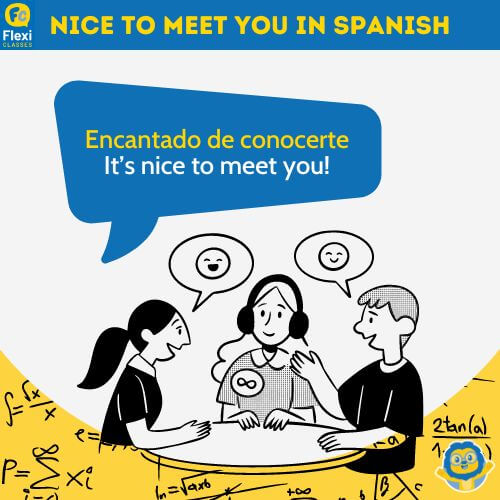
First impressions are what count, or so the adage goes.
So if we want to make a good and lasting impression on our new Spanish acquaintances after an introduction, let’s learn the basics of saying, ‘Nice to meet you’, in Spanish.
Let’s picture a likely scenario, you’re in Spain, with a group of Spanish friends and one of them bumps into one of their university classmates and they initiate a conversation.
It is expected and polite that your Spanish friend then introduces you to this newly encountered person. Introductions follow and now you’ve been formally introduced and the ball is in your court.
👉 How should you reply?
This article has you covered. Keep calm and carry on reading.
Nice To Meet You in Spanish || Formal Introductions and the All Around Reply
Nice to Meet You in Spanish || The Casual and Short Variation
Nice to Meet You in Spanish || Let’s Get Creative: Other Ways to Say Nice to Meet You in Spanish
Nice to Meet You in Spanish || Nice to Meet You as a Goodbye
Nice to Meet You in Spanish || FAQs
Nice To Meet You in Spanish || Formal Introductions and the All Around Reply
👉 After a formal introduction to a person with whom – up to that moment – we were not acquainted, in Spain the most common reply by far would be encantado de conocerte or encantada de conocerte (‘Nice to meet you’ or ‘Pleased to meet you’).
| Spanish | English |
|---|---|
| encantado de conocerte | Nice to meet you (male) |
| encantada de conocerte | Pleased to meet you (female) |
| te presento a tu nuevo profesor | Let me introduce you to your new teacher |
Did you know?: de conocerte will vary depending on whether the person who is receiving the introduction is male (encantado) or female (encantada).
Let’s do a bit of role-play
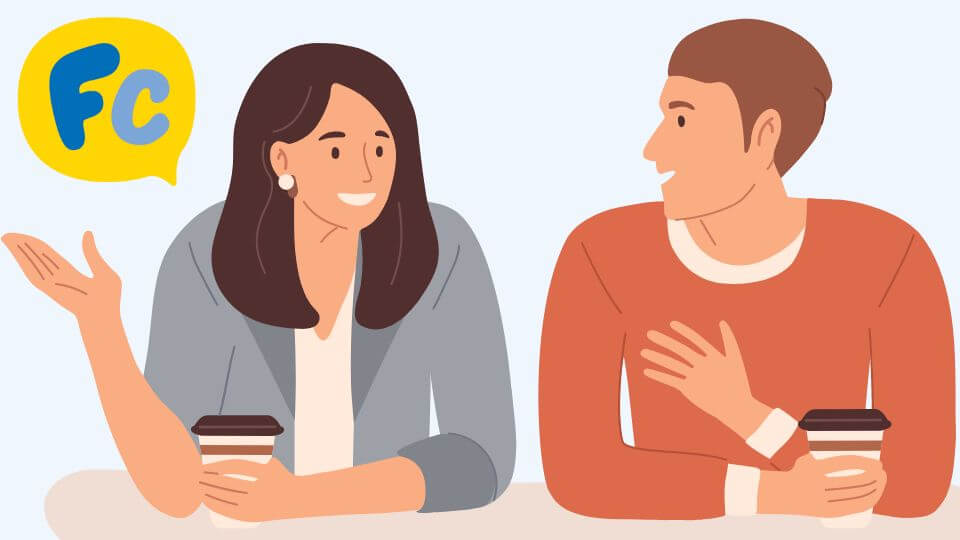
Hola, qué tal me llamo Begoña.
Hi, how are you, my name is Begoña.Encantado de conocerte, Begoña.
It’s nice to meet you Begoña.👆In the above conversation, Fernando was being introduced to Begoña, so in reply, he used the masculine form encantado (de conocerte). The masculine form in this case indicates that Fernando is the one pleased to meet Begoña.
🔎 A tip: You can use this form of reply to an introduction in either a formal or an informal context. Although, in case you wish to address someone more respectfully with the formal you (Usted), substitute the informal pronoun ‘te’ with the formal one ‘le’ at the end of the word conocer. Like so:
Encantado de conocerle (or encantada de conocerle ).
It is always safer to adapt the level of formality of your response based on the context and especially depending on the person you are addressing. An example:
Pablo, te presento a tu nuevo profesor, el Señor Fuentes.
Pablo, let me introduce you to your new teacher, Mr. Fuentes.Pablo
Encantado de conocerle, Señor Fuentes.
It’s nice to meet you Mr. Fuentes.🔐 Note that Pablo used the formal ending pronoun ‘le’ (conocerle) when addressing his teacher, as a sign of respect.
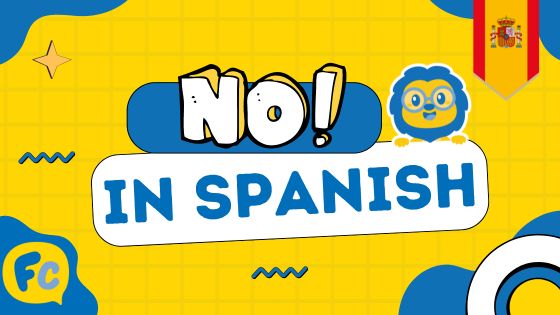
Saying No in Spanish – When No Doesn’t Necessarily Mean No
No in Spanish Formal Expressions, Slang and Indirect Refusals A straightforward ‘no’ in Spanish is said the same way and just as directly as it is in English, no. ❌ However, a negative response in Spanish is often adorned and…
Nice to Meet You in Spanish ||
The Casual and Short Variation
👉 If after having been introduced to someone, in response we want to keep it a bit more casual, it’s perfectly acceptable to use the abbreviated form of encantado de conocerte, by simply saying: encantado or encantada (remember, it’s gender sensitive.)
So if you’re around friends, at a party or in any casual setting, the conversation might look something like this:
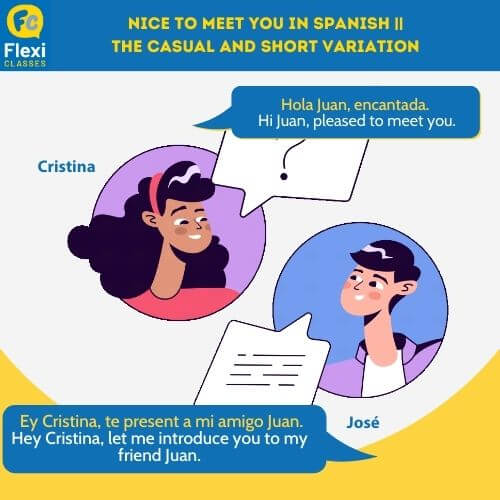

8 Ways to Say Hi in Spanish – Say Hello Like a Local
Different Ways of Saying Hi in Spanish, Fit for Each Occasion! There are many ways to say hello in Spanish, based on several factors… Is it a formal or an informal occasion? Are you close friends or have you just…
Nice to Meet You in Spanish || Let’s Get Creative: Other Ways to Say Nice to Meet You in Spanish
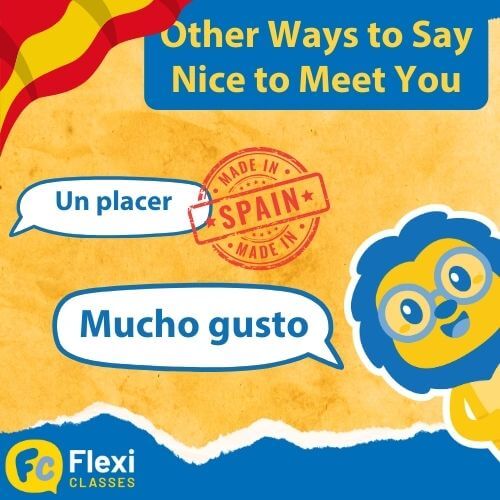
– Un placer . Another courteous response to an introduction would be Un placer (‘A pleasure’) or Un placer conocerte (‘A pleasure to meet you’).
Again, the ending pronoun ‘te’ in conocerte can be substituted with the formal you (Usted) pronoun ‘le’, should it be more suitable to the context or the person being addressed). Like so: Un placer conocerle.
– Mucho gusto . This form of response – that translates as well as ‘Nice to meet you’ – is acceptable, although far more commonly used in Latin American countries than it is in Spain.
– Qué tal . If we’re feeling very casual, in a relaxed context, like maybe out with friends and you’re introduced to someone, a substitute reply to the standard encantado or encantada would be qué tal (how’re you) or hola, qué tal (‘hi, how’re you’).
| Spanish | English |
|---|---|
| Un placer | A pleasure |
| Un placer conocerte/ conocerle | A pleasure to meet you |
| Qué tal | How’re you? |
| Hola, qué tal | Hi, how’re you? |
👉 Let’s play this conversation out, one wherein someone is introduced over drinks:
¿María, qué haces por aquí, pensaba que te habías trasladado a Alemania?
María, what are you doing here? I thought you had moved to Germany?¡Pues sí, vivo en Berlín, pero estoy aquí de vacaciones!
Why yes, I live in Berlin but am here on vacation!Speak Pues deja que te presente a mi amiga Marta.
Then let me introduce you to my friend Marta.Qué tal. Tómate algo con nosotros.
How’re you. Have a drink with us.🔐 Note how Marta simply responded to the introduction with a more casual Qué tal (‘How’re you’).
Nice to Meet You in Spanish ||
Nice to Meet You as a Goodbye
👉 The same standard expression encantado de conocerte or the abbreviated encantado/a can equally be used as a parting phrase and is a polite way of ending a conversation with someone you’ve been introduced to.
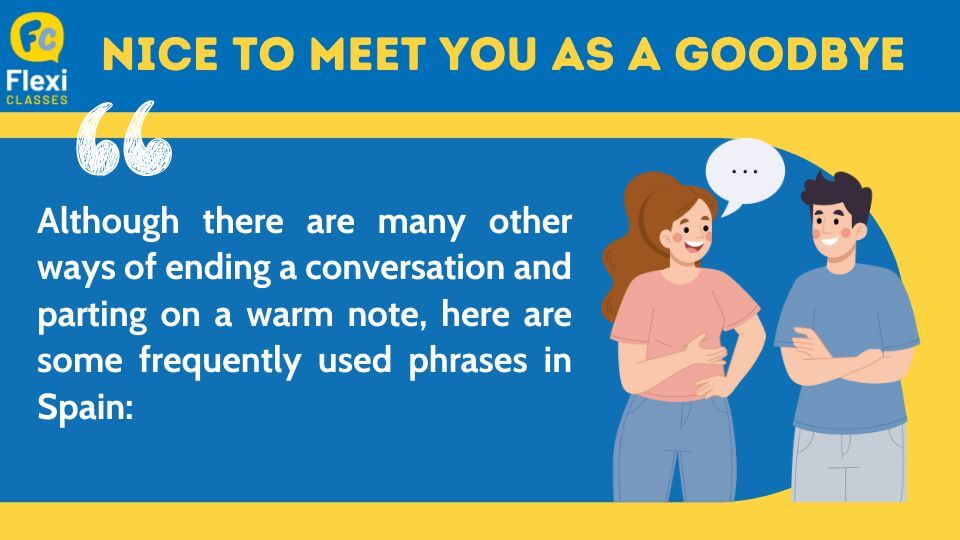
| Spanish | English |
|---|---|
| Un placer | A pleasure |
| Un placer conocerte | A pleasure meeting you |
| Un gusto conocerte | literally expresses delight in meeting someone and is another way of saying ‘Nice to meet you’ |
| Ha sido un gusto | It’s been delightful |
| Me alegra haberte conocido | I’m happy to have met you |
🔎 A tip: You can always switch things around and make some of these expressions more respectful by substituting the informal pronoun ‘te’ with the formal ‘le’.
An example, Un placer conocerle would be the more formal/respectful equivalent of Un placer conocerte .
🌎 Learning languages to travel? Why not check out How to Say Nice to Meet You in Japanese

Spanish Days of the Week – Essential Beginner Vocabulary
Days of the Week in Spanish || How to make the Most Out of Your Week like a True Spaniard 📆 🇪🇸 For starters, a bit of mnemonics to help you remember the Spanish days of the week. Let’s Meet…
Nice to Meet You in Spanish || FAQs
How to respond to encantado/a de conocerte?
The most common response after the cordial encantado/a de conocerte (‘Nice to meet you’) is igualmente (likewise). Another common reply would be: lo mismo digo (equivalent to saying, ‘same to you’).
🔎 A tip: You can throw in a gracias (‘thank you’) there as well. Like so: ¡Gracias, lo mismo digo¡ (‘Thank you, same to you!) or ¡Gracias, igualmente¡ (‘Thank you, likewise!).
When to use encantado or encantada?
When the person responding to an introduction is male, use the masculine, encantado: Encantado de conocerte or simply Encantado.
When the person responding to an introduction is female, use the feminine, encantada: Encantada de conocerte or simply Encantada
What is the difference between mucho gusto and encantado?
While both are acceptable and equally translate to ‘Nice to meet you’, Mucho gusto is more frequently used in Latin American Spanish-speaking countries.
Encantado (or encantada, when the person responding to the introduction is female), would be considered the go-to reply in Spain after an introduction.
Is encantado formal or informal?
The phrase encantado de conocerte or its abbreviated encantado (or encantada, when the person responding to the introduction is female) can be used in both informal and formal contexts.
Should you wish to convey additional respect when using the phrase, just substitute the informal ‘te’ pronoun located at the end of the word conocerte for the formal ‘le’, referring to the formal ‘you’ (Usted), like so: Encantado de conocerle.
How do you say ‘nice to meet you’ to a group in Spanish?
When addressing a group collectively, here are a couple of go-to options:
Encantado/a de conoceros (‘Pleased to meet you all – to address a group informally)
Encantado/a de conocerles – (‘Pleased to meet you all’ – to formally address a group)
Want More From LTL?
FANCY LEARNING SPANISH? Check out our online Spanish courses here.
We offer a 7-day free trial to all online students where you can study Spanish 24/7. It doesn’t end there either.
We teach over 10 of the world’s most popular languages 😎
Come and be a part of our amazing community.









